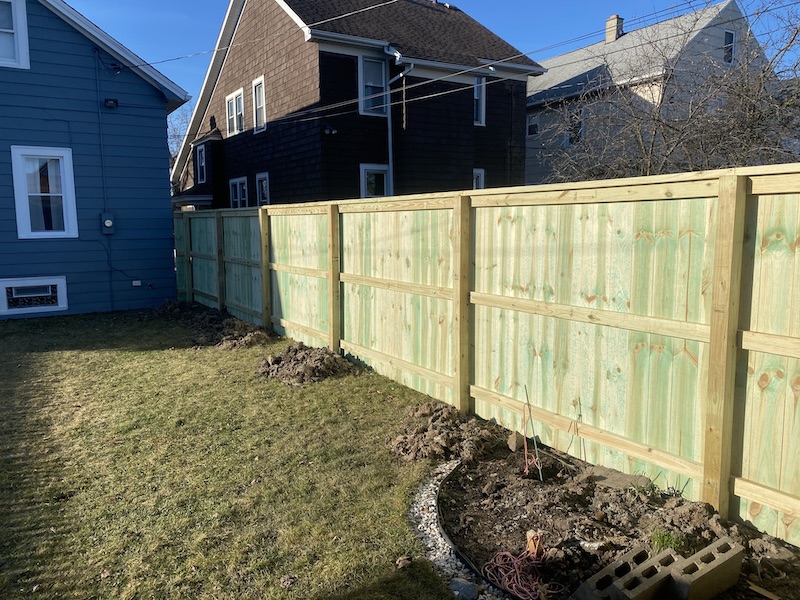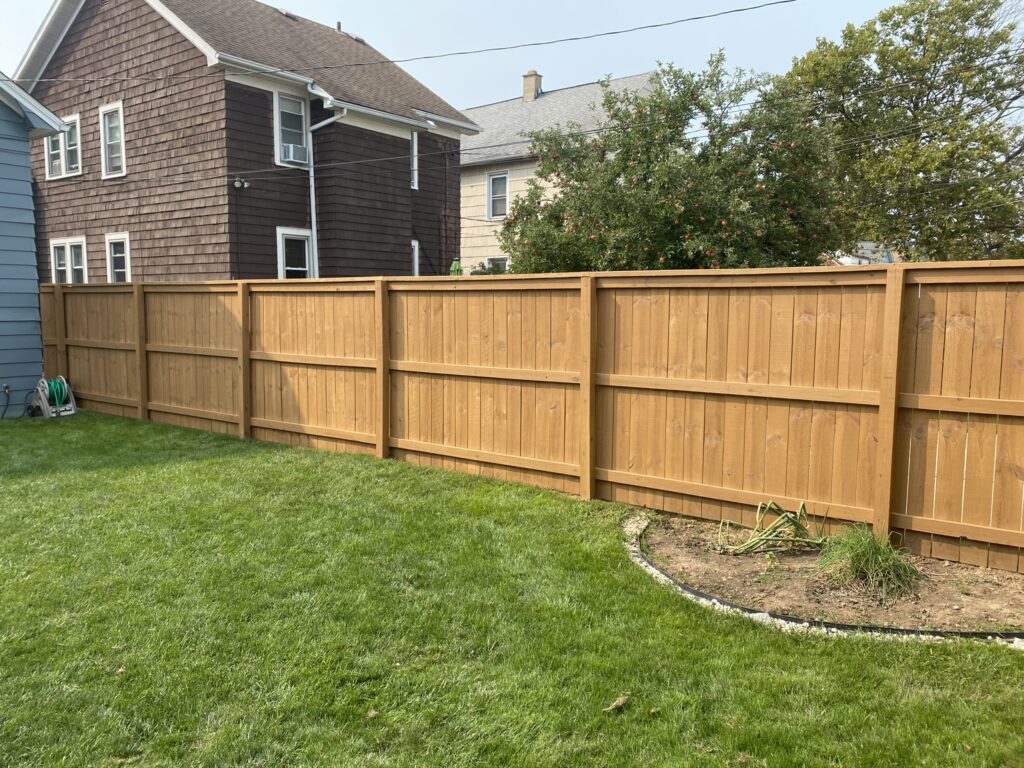In 2022, we decided to stop offering fence staining services. This page should give customers some advice on how fence staining works. Please call us for a recommendation on a fence-staining company that can help with your project.
—
There are a couple of things that need to be taken into consideration when planning on staining a fence. The weather obviously plays a major role in the timing of the fence staining. It is important that the moisture content of the wood to be stained is ideal for the project to take place and to ensure a uniform finish. Some types of wood hold moisture or dry out at different rates than others. Wood naturally absorbs and releases water in order to balance its internal water content to match its surroundings. Water itself does not harm the wood, but experts recommend that 19% water-weight is the maximum safe water content of wood before decaying organisms can begin to grow.
This is a link to the Behr website where they give some important project recommendations. Our staining process is outlined below and adheres to all of Behr’s recommended steps for using their stain products.
Our standard process for staining a fence:
1) Examine condition of wood to be stained.
Does the fence need any structural repairs before staining? Is the wood too deteriorated?
We use a company called Green Genie Environmental to prep any wood fence that we apply stain to. They apply an organic chemical (no harm to plants or animals) to the fence that removes any mold, mildew, algae, or failed stain. On brand new wood, they remove something called millglaze. Millglaze happens when lumber is cut in a lumber mill using high speed saw blades, which draws out sap and moisture from the wood. This dries on the surface of the wood, leaving a film. GreenGenie removes this and opens up the wood pores, so the coat of stain soaks in correctly and looks uniform.
- After applying any water methods to return the fence to a stainable condition it is given time to dry out. The length of time needed to dry out the fence is determined by the weather (in hot and dry weather the wood will dry out in a couple days). A moisture meter is used to determine the water content of the wood on staining day.
.
2) Protect any surfaces around the fence.
- Making sure the area around the fence is protected before applying cleaning process solutions or stain is the most time consuming, but also the most important part of the staining process.
- Any vehicles should be moved away from the work area.
- Plants, bushes, and trees in close proximity to the area are covered with a tarp or protective plastic sheeting.
- A tarp is also placed in between the fence and any buildings or structures.
- We tarp off the entire fence before we begin spraying any stain.
- Fence company signs are removed before staining and replaced afterward.
.
3) Apply stain to the fence
- After the overspray system is set up the actual spraying of the fence can begin.
- We generally begin staining on the side of the fence where there is more surface area to be covered (the side with posts and rails versus the picket only side). This gives us a chance to judge how much stain we will need to finish the project when we get to the halfway point.
- Basically, one panel (generally 8 feet wide) is stained at a time. The panel is sprayed and then back-brushed. This is repeated for each panel in a line.
- When the entire fence has one coat of stain applied to it, the process is repeated for the second coat. The only difference is the second coat is applied lighter and does not require as much back-brushing.
- Stain dry time will generally depend on temperature and humidity. Full stain curing time is normally 72 hours.
 Photo: before staining
Photo: before staining
 Photo: after staining Behr Cedar (St-146)
Photo: after staining Behr Cedar (St-146)
Timing:
The fence staining season in Western New York generally runs from April until October. This is weather dependent and the minimum temperature that stain should be applied at is 45 degrees Fahrenheit.
- The length of time the actual staining will take will vary with each project based on size and fence style. A fence should be stained continuously, so the maximum length for staining a fence is one day. Prep work before staining may take a day or longer, with dry time added in between prep and staining.
- Example: We stained 365 linear feet of 6 foot high fence in September 2015. We arrived on the job site around 7am and didn’t leave the job site until 9pm.
